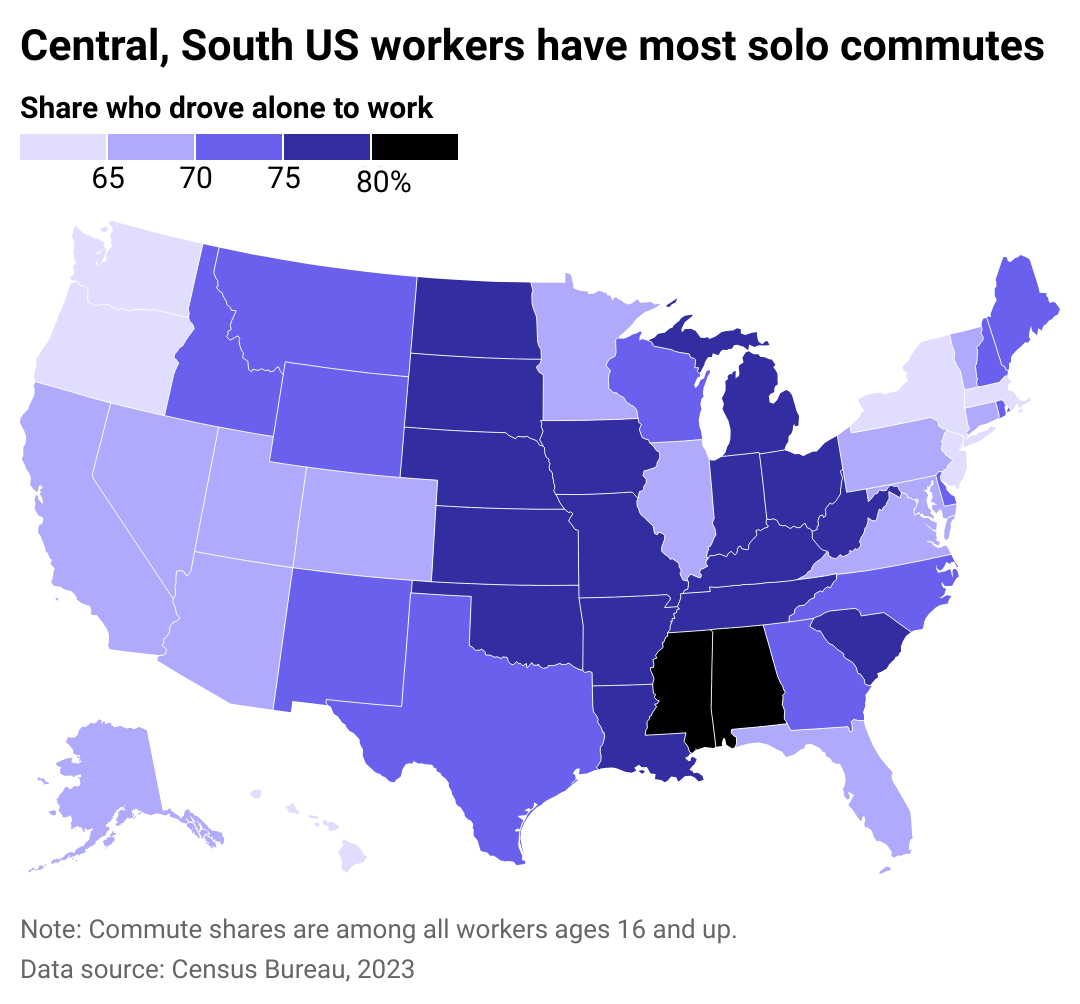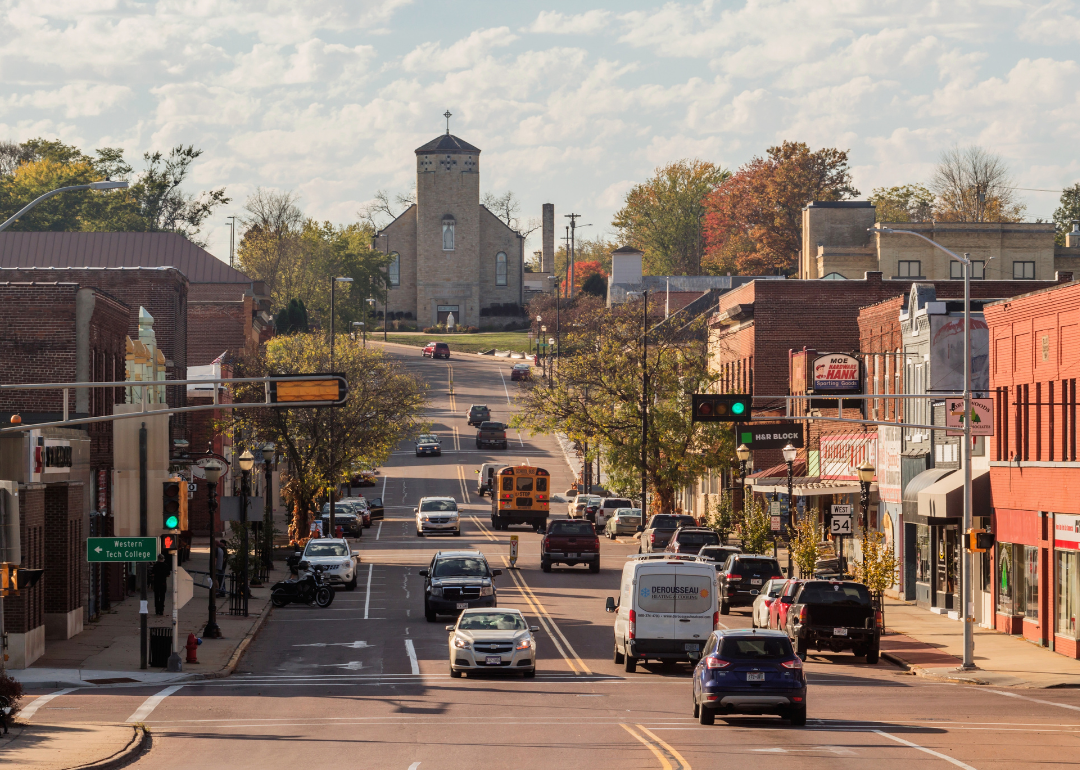
Lonely road: The counties in Wisconsin where people drive to work alone the most
This story originally appeared on Truck Parking Club and was produced and distributed in partnership with Stacker Studio.
Lonely road: The counties in Wisconsin where people drive to work alone the most
Rush hours are infamous for densely packed streets, seas of brake lights, and raging commuters—all products of a population that mostly drives alone.
About 7 in 10 Americans drive alone to work. That marks a new standard for the U.S. in the wake of the COVID-19 pandemic, which caused drive-alone commutes to drop as remote work became more widespread. Even so, driving alone remains the primary commuting method in the nation.
To identify areas where solo commutes remain most common, Truck Parking Club used Census Bureau data to map states by the share of people who drive to work alone, and to rank Wisconsin counties by their drive-alone rates. State-level figures are from 2023, while county-level data and comparisons are for 2022—the most recent data available in both cases. The analysis draws on other surveys and research to identify why these areas have more solo commuters and how it impacts individuals and their communities.
Americans drive alone to work more than their counterparts in peer nations. Across a selection of six countries, including China, Germany, and Brazil, the share of U.S. commuters who drove alone led the other nations by at least 10 percentage points in 2022, according to Statista's Global Consumer Survey. Researchers from the University of California, Berkeley, and other institutions found that most American cities have less access to jobs by walking or cycling than in European cities, and transit access to jobs falls behind other major cities throughout the world, according to a 2021 article in the journal Nature.
Research also shows that these driving habits often lead to physical inactivity, stress, anxiety, air-quality related health concerns, and a higher risk of car accidents. A high volume of people driving their own cars also creates congestion, which costs Americans valuable time—$733 worth of time on average in 2023 while spending 42 hours in traffic, according to data from transportation insights company Inrix. Some U.S. city economies lost billions in productivity and supply chain delays.
U.S. drive-alone rates hovered between 76% to 78% for decades, but dropped during the COVID-19 pandemic, falling to 68% in 2021. The rates have continued to hover below 70% through 2023, mitigating the adverse effects of driving alone. What's more, younger Americans acquire driver's licenses less often than previous generations, according to an analysis of Census data by the Washington Post published in 2023, meaning there are fewer drivers among the working-age population.
Still, the drop in drive-alone commutes has not happened evenly across the country. Read on to see where Americans—and Wisconsin residents—continue driving alone to work at the highest rates.

In the Northwest and mid-Atlantic, people drive to work alone at the lowest rates
In Wisconsin, 74.9% of workers over 16 drove alone for their commutes in 2023.
In general, states in the central part of the country had the highest rates of drive-alone commutes, between the central South and Midwest. Mississippi and Alabama were the top states for solo commutes, with about 8 in 10 people driving alone to work. They were followed closely by neighboring Louisiana and Arkansas, where 78.7% and 78.3% of commuters drove alone, respectively.
As of 2023, these states had below-average rates of remote work as compared to the rest of the nation. In Mississippi, for instance, only 5.5% of people worked from home, compared to 15.2% nationally. Lacking opportunities to work remotely, commuters in these states maintained their solo drives.
Most leading states also have below-average gas prices, making drive-alone commutes more affordable. And with lower population density, there is more space between homes and workplaces, making other transportation modes less feasible.
Meanwhile, states in the Northeast and Northwest have lower drive-alone rates. In New York, fewer than half of workers drive alone to work. Solo drivers comprise between 62% and 65% of commuters in Massachusetts, New Jersey, Hawai'i, Oregon, and Washington. Each has some combination of population density, heightened environmental consciousness, existing or expanding infrastructure for public transit, cycling, and walkability, and incentives for carpooling. As a result, residents of the Northeast and Northwest are more likely to use alternative commute methods.
Additionally, the Northeast and Northwest offer plentiful jobs in business, finance, information, and other professional services—industries with more capabilities for remote work, per 2023 data from the Bureau of Labor Statistics. Most employers in these industries increased telework after the pandemic's onset and continue to offer it at higher rates than the economy overall, BLS data shows. This further minimizes the need for drive-alone commutes in those areas.
Remote work opportunities have fallen since the pandemic's peak, and some have reverted back to their former driving habits. However, as the return of heavy traffic harms people's health, the economy, and the planet, and as gas prices in most areas of the country remain high, individuals and communities may continue seeking ways to cut down on their driving trips.
Read on to see the counties in Wisconsin with the most drive-alone commutes.

#50. Burnett County (tie)
- Workers who drove alone: 77.4%
- Difference from state share: 2.5 percentage points higher
- Difference from national share: 5.7 percentage points higher

#50. Dunn County (tie)
- Workers who drove alone: 77.4%
- Difference from state share: 2.5 percentage points higher
- Difference from national share: 5.7 percentage points higher

#50. La Crosse County (tie)
- Workers who drove alone: 77.4%
- Difference from state share: 2.5 percentage points higher
- Difference from national share: 5.7 percentage points higher

#50. Lafayette County (tie)
- Workers who drove alone: 77.4%
- Difference from state share: 2.5 percentage points higher
- Difference from national share: 5.7 percentage points higher

#49. Walworth County
- Workers who drove alone: 77.8%
- Difference from state share: 2.9 percentage points higher
- Difference from national share: 6.1 percentage points higher

#47. Door County (tie)
- Workers who drove alone: 77.9%
- Difference from state share: 3.0 percentage points higher
- Difference from national share: 6.2 percentage points higher

#47. Forest County (tie)
- Workers who drove alone: 77.9%
- Difference from state share: 3.0 percentage points higher
- Difference from national share: 6.2 percentage points higher

#45. Marathon County (tie)
- Workers who drove alone: 78%
- Difference from state share: 3.1 percentage points higher
- Difference from national share: 6.3 percentage points higher

#45. Monroe County (tie)
- Workers who drove alone: 78%
- Difference from state share: 3.1 percentage points higher
- Difference from national share: 6.3 percentage points higher

#44. Chippewa County
- Workers who drove alone: 78.1%
- Difference from state share: 3.2 percentage points higher
- Difference from national share: 6.4 percentage points higher

#43. Jackson County
- Workers who drove alone: 78.2%
- Difference from state share: 3.3 percentage points higher
- Difference from national share: 6.5 percentage points higher

#41. Eau Claire County (tie)
- Workers who drove alone: 78.3%
- Difference from state share: 3.4 percentage points higher
- Difference from national share: 6.6 percentage points higher

#41. St. Croix County (tie)
- Workers who drove alone: 78.3%
- Difference from state share: 3.4 percentage points higher
- Difference from national share: 6.6 percentage points higher

#40. Jefferson County
- Workers who drove alone: 78.4%
- Difference from state share: 3.5 percentage points higher
- Difference from national share: 6.7 percentage points higher

#39. Ozaukee County
- Workers who drove alone: 78.5%
- Difference from state share: 3.6 percentage points higher
- Difference from national share: 6.8 percentage points higher

#38. Sauk County
- Workers who drove alone: 78.6%
- Difference from state share: 3.7 percentage points higher
- Difference from national share: 6.9 percentage points higher

#37. Columbia County
- Workers who drove alone: 78.9%
- Difference from state share: 4.0 percentage points higher
- Difference from national share: 7.2 percentage points higher

#36. Waukesha County
- Workers who drove alone: 79.1%
- Difference from state share: 4.2 percentage points higher
- Difference from national share: 7.4 percentage points higher

#35. Buffalo County
- Workers who drove alone: 79.4%
- Difference from state share: 4.5 percentage points higher
- Difference from national share: 7.7 percentage points higher

#33. Oneida County (tie)
- Workers who drove alone: 79.6%
- Difference from state share: 4.7 percentage points higher
- Difference from national share: 7.9 percentage points higher

#33. Richland County (tie)
- Workers who drove alone: 79.6%
- Difference from state share: 4.7 percentage points higher
- Difference from national share: 7.9 percentage points higher

#31. Shawano County (tie)
- Workers who drove alone: 79.7%
- Difference from state share: 4.8 percentage points higher
- Difference from national share: 8.0 percentage points higher

#31. Winnebago County (tie)
- Workers who drove alone: 79.7%
- Difference from state share: 4.8 percentage points higher
- Difference from national share: 8.0 percentage points higher

#30. Kewaunee County
- Workers who drove alone: 79.8%
- Difference from state share: 4.9 percentage points higher
- Difference from national share: 8.1 percentage points higher

#28. Brown County (tie)
- Workers who drove alone: 80%
- Difference from state share: 5.1 percentage points higher
- Difference from national share: 8.3 percentage points higher

#28. Menominee County (tie)
- Workers who drove alone: 80%
- Difference from state share: 5.1 percentage points higher
- Difference from national share: 8.3 percentage points higher

#27. Green County
- Workers who drove alone: 80.1%
- Difference from state share: 5.2 percentage points higher
- Difference from national share: 8.4 percentage points higher

#25. Oconto County (tie)
- Workers who drove alone: 80.2%
- Difference from state share: 5.3 percentage points higher
- Difference from national share: 8.5 percentage points higher

#25. Racine County (tie)
- Workers who drove alone: 80.2%
- Difference from state share: 5.3 percentage points higher
- Difference from national share: 8.5 percentage points higher

#22. Fond du Lac County (tie)
- Workers who drove alone: 80.3%
- Difference from state share: 5.4 percentage points higher
- Difference from national share: 8.6 percentage points higher

#22. Trempealeau County (tie)
- Workers who drove alone: 80.3%
- Difference from state share: 5.4 percentage points higher
- Difference from national share: 8.6 percentage points higher

#22. Wood County (tie)
- Workers who drove alone: 80.3%
- Difference from state share: 5.4 percentage points higher
- Difference from national share: 8.6 percentage points higher

#19. Lincoln County (tie)
- Workers who drove alone: 80.5%
- Difference from state share: 5.6 percentage points higher
- Difference from national share: 8.8 percentage points higher

#19. Outagamie County (tie)
- Workers who drove alone: 80.5%
- Difference from state share: 5.6 percentage points higher
- Difference from national share: 8.8 percentage points higher

#19. Rusk County (tie)
- Workers who drove alone: 80.5%
- Difference from state share: 5.6 percentage points higher
- Difference from national share: 8.8 percentage points higher

#18. Juneau County
- Workers who drove alone: 80.7%
- Difference from state share: 5.8 percentage points higher
- Difference from national share: 9.0 percentage points higher

#14. Adams County (tie)
- Workers who drove alone: 80.9%
- Difference from state share: 6.0 percentage points higher
- Difference from national share: 9.2 percentage points higher

#14. Calumet County (tie)
- Workers who drove alone: 80.9%
- Difference from state share: 6.0 percentage points higher
- Difference from national share: 9.2 percentage points higher

#14. Dodge County (tie)
- Workers who drove alone: 80.9%
- Difference from state share: 6.0 percentage points higher
- Difference from national share: 9.2 percentage points higher

#14. Sheboygan County (tie)
- Workers who drove alone: 80.9%
- Difference from state share: 6.0 percentage points higher
- Difference from national share: 9.2 percentage points higher

#13. Price County
- Workers who drove alone: 81%
- Difference from state share: 6.1 percentage points higher
- Difference from national share: 9.3 percentage points higher

#12. Waushara County
- Workers who drove alone: 81.1%
- Difference from state share: 6.2 percentage points higher
- Difference from national share: 9.4 percentage points higher

#8. Iron County (tie)
- Workers who drove alone: 81.2%
- Difference from state share: 6.3 percentage points higher
- Difference from national share: 9.5 percentage points higher

#8. Kenosha County (tie)
- Workers who drove alone: 81.2%
- Difference from state share: 6.3 percentage points higher
- Difference from national share: 9.5 percentage points higher

#8. Manitowoc County (tie)
- Workers who drove alone: 81.2%
- Difference from state share: 6.3 percentage points higher
- Difference from national share: 9.5 percentage points higher

#8. Polk County (tie)
- Workers who drove alone: 81.2%
- Difference from state share: 6.3 percentage points higher
- Difference from national share: 9.5 percentage points higher

#6. Rock County (tie)
- Workers who drove alone: 81.3%
- Difference from state share: 6.4 percentage points higher
- Difference from national share: 9.6 percentage points higher

#6. Washington County (tie)
- Workers who drove alone: 81.3%
- Difference from state share: 6.4 percentage points higher
- Difference from national share: 9.6 percentage points higher

#5. Marquette County
- Workers who drove alone: 81.4%
- Difference from state share: 6.5 percentage points higher
- Difference from national share: 9.7 percentage points higher

#4. Marinette County
- Workers who drove alone: 82.3%
- Difference from state share: 7.4 percentage points higher
- Difference from national share: 10.6 percentage points higher

#3. Waupaca County
- Workers who drove alone: 82.5%
- Difference from state share: 7.6 percentage points higher
- Difference from national share: 10.8 percentage points higher

#2. Florence County
- Workers who drove alone: 83.1%
- Difference from state share: 8.2 percentage points higher
- Difference from national share: 11.4 percentage points higher

#1. Langlade County
- Workers who drove alone: 84.4%
- Difference from state share: 9.5 percentage points higher
- Difference from national share: 12.7 percentage points higher
This story features data reporting and writing by Paxtyn Merten and is part of a series utilizing data automation across 50 states.



